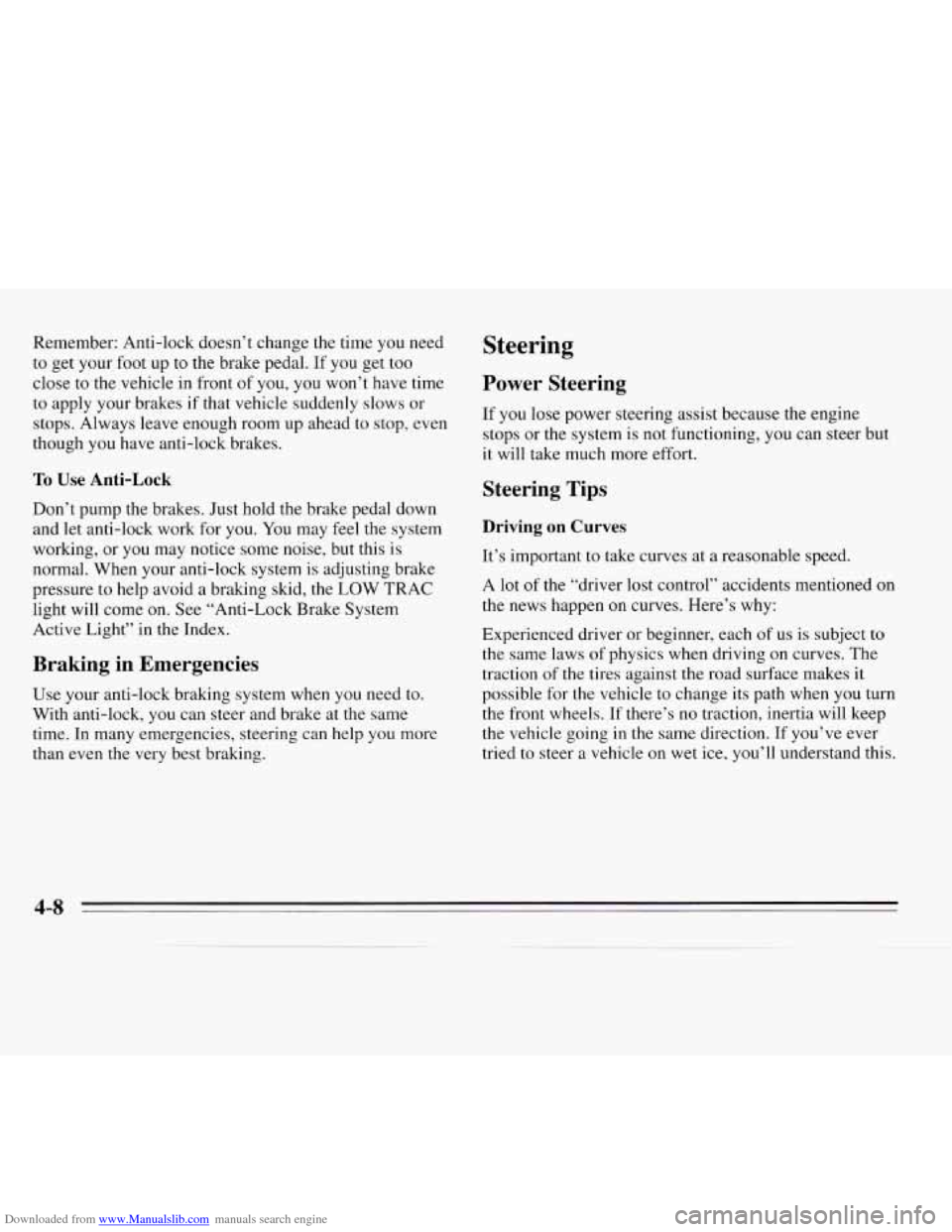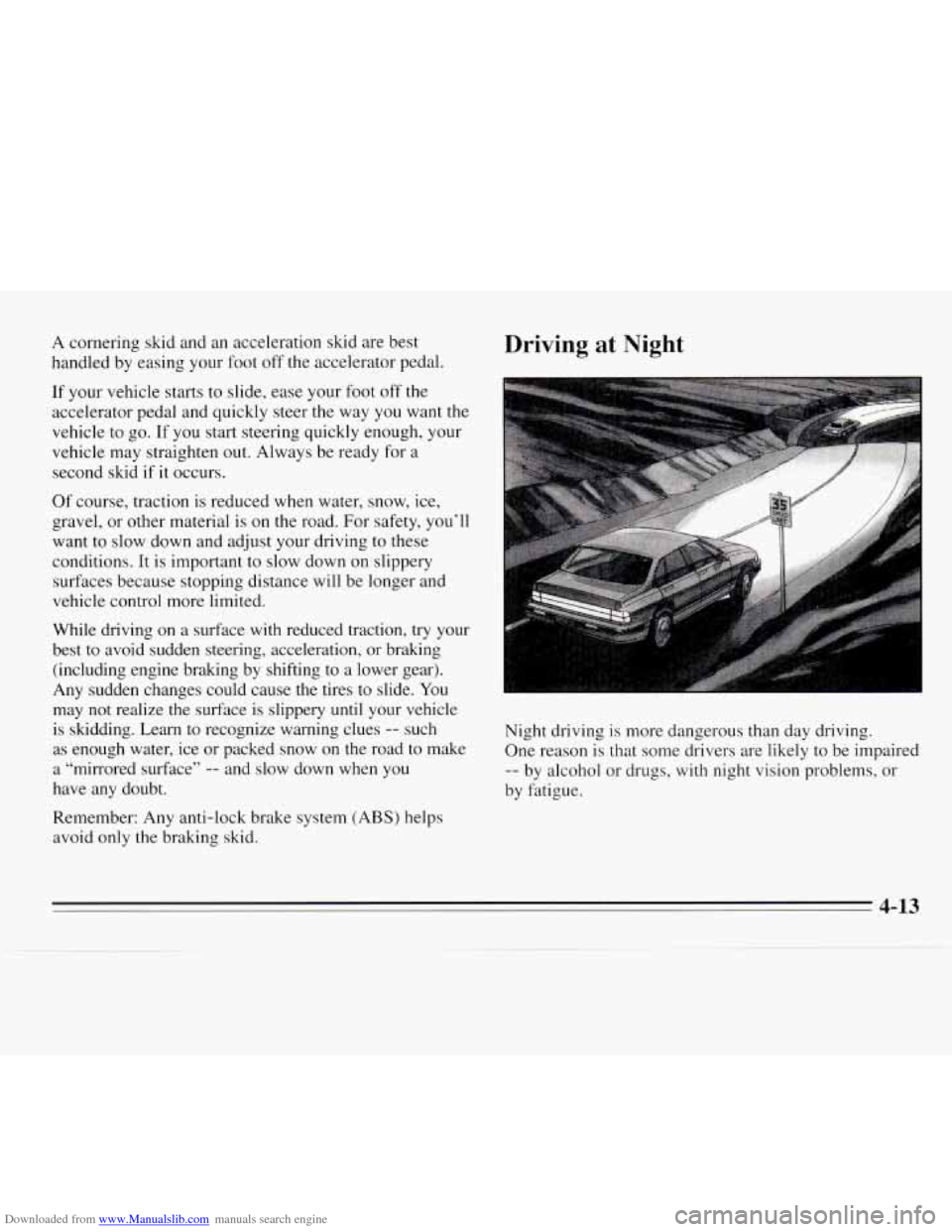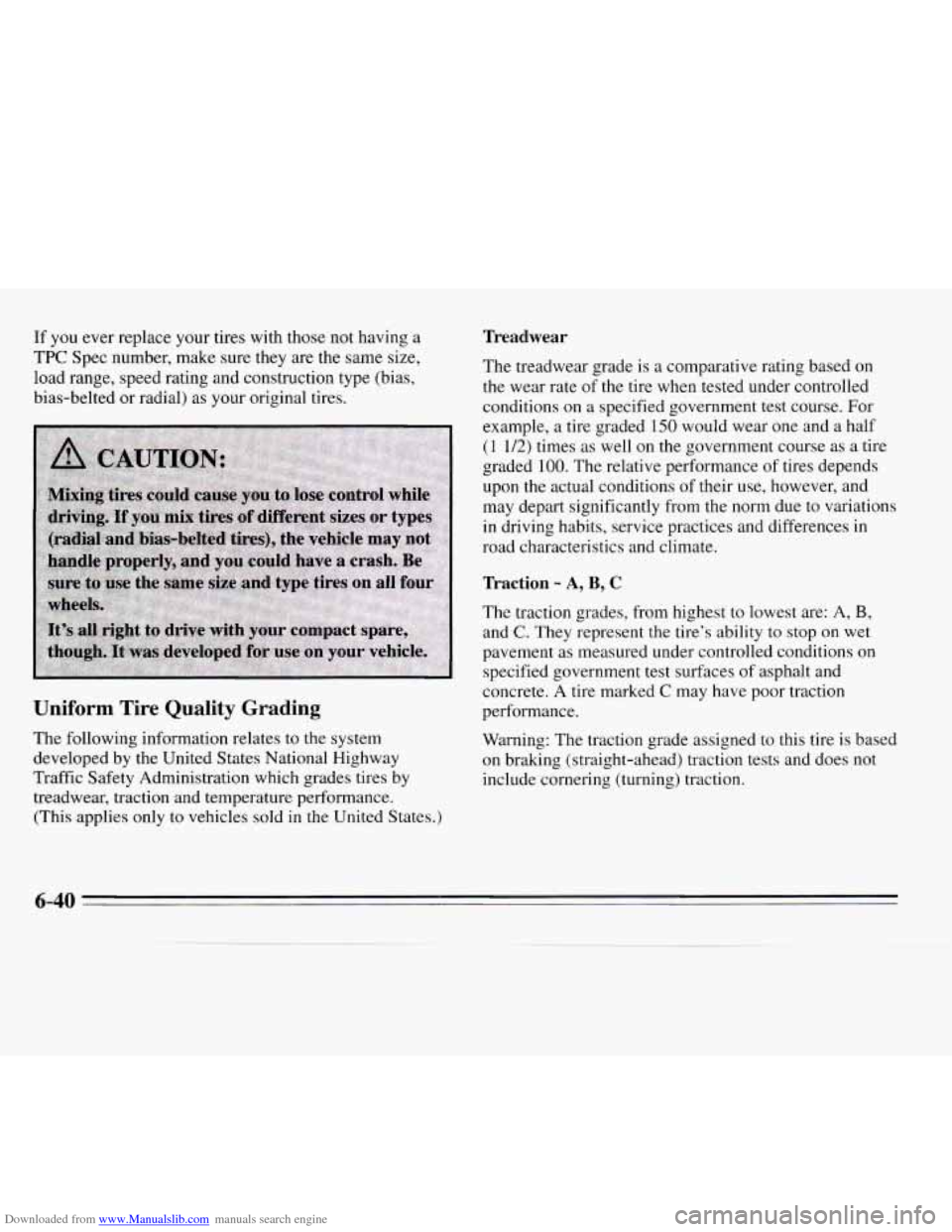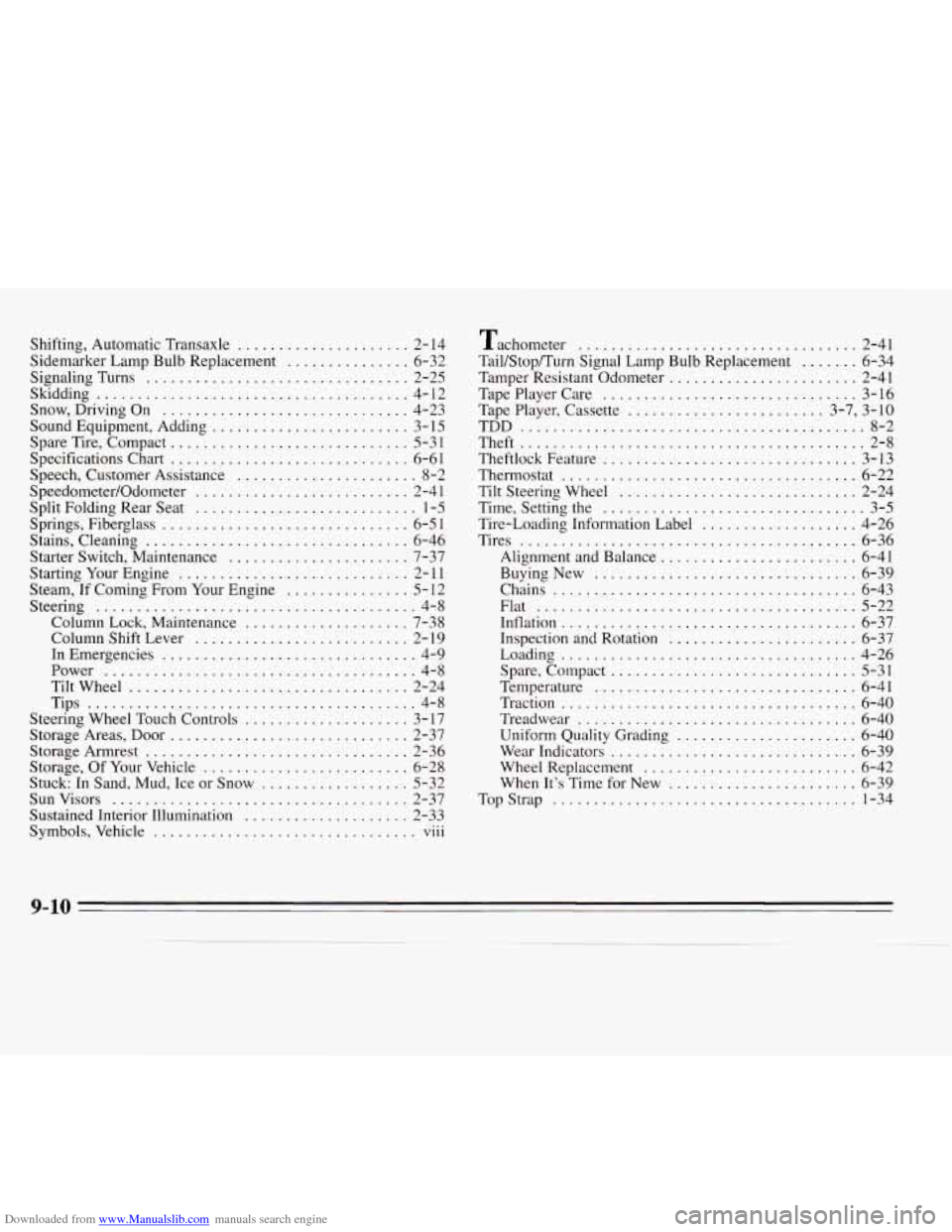1995 CHEVROLET MONTE CARLO traction control
[x] Cancel search: traction controlPage 136 of 324

Downloaded from www.Manualslib.com manuals search engine Remember: Anti-lock doesn’t change the time you need
to get your foot up to the brake pedal. If you get too
close to the vehicle in front of you, you won’t have time
to apply your brakes if that vehicle suddenly slows or
stops. Always leave enough room up ahead
to stop, even
though
you have anti-lock brakes.
To Use Anti-Lock
Don’t pump the brakes. Just hold the brake pedal down
and let anti-lock work for you.
You may feel the system
worhng, or you may notice some noise, but this is
normal. When your anti-lock system
is adjusting brake
pressure to help avoid a braking skid, the
LOW TRAC
light will come on. See “Anti-Lock Brake System
Active Light” in the Index.
Braking in Emergencies
Use your anti-lock braking system when you need to.
With anti-lock, you can steer and brake at the same
time.
In many emergencies, steering can help you more
than even the
very best braking.
Steering
Power Steering
If you lose power steering assist because the engine
stops or the system is not functioning, you can steer but
it will take much more effort.
Steering Tips
Driving on Curves
It’s important to take curves at a reasonable speed.
A
lot of the “driver lost control” accidents mentioned on
the news happen on curves. Here’s why:
Experienced driver
or beginner, each of us is subject to
the same laws of physics when driving on curves. The
traction of the tires against the road surface makes
it
possible for the vehicle to change its path when you turn
the front wheels. If there’s no traction, inertia will keep
the vehicle going in the same direction. If you’ve ever
tried to steer
a vehicle on wet ice, you’ll understand this.
Page 137 of 324

Downloaded from www.Manualslib.com manuals search engine The traction you can get in a curve depends on the
condition of your tires and the road surface, the angle at
which the curve is banked, and your speed. While
you’re
in a curve, speed is the one factor you can control.
Suppose you’re steering through
a sharp curve. Then you
suddenly accelerate. Both control systems
-- steering and
acceleration
-- have to do their work where the tires meet
the road. Adding the sudden acceleration can demand too
much
of those places. You can lose control.
What should you do if this ever happens? Ease up on the
accelerator pedal, steer the vehicle the way you want it
to go, and slow down.
Speed limit signs near curves warn that you should
adjust your speed. Of course, the posted speeds are
based on good weather and road conditions. Under less
favorable conditions you’ll want to go slower.
If
you need to reduce your speed as you approach a
curve, do it before you enter the curve, while your front
wheels are straight ahead.
Try to adjust your speed
so you can “drive” through the
curve. Maintain a reasonable, steady speed. Wait to
accelerate until you are out
of the curve, and then
accelerate gently into the straightaway.
Steering in Emergencies
There are times when steering can be more effective
than braking. For example, you come over a hill and
find
a truck stopped in your lane, or a car suddenly pulls
out from nowhere, or
a child darts out from between
parked cars and stops right in front of you. You can
avoid these problems by braking
-- if you can stop in
time. But sometimes you can’t; there isn’t room. That’s
the time for evasive action
-- steering around the
problem.
Your Chevrolet can perform very well in emergencies
like these. First apply your brakes. (See “Braking in
Emergencies” earlier
in this section.) It is better to
remove as much speed as you can from a possible
collision. Then steer around the problem, to the left or
right depending on the space available.
4-9
Page 141 of 324

Downloaded from www.Manualslib.com manuals search engine A cornering skid and an acceleration skid are best
handled by easing your foot off the accelerator pedal.
If your vehicle starts to slide, ease your foot off
the
accelerator pedal and quickly steer the way you want the
vehicle to go. If you start steering quickly enough, your
vehicle may straighten out. Always be ready for a
second skid if it occurs.
Of course, traction is reduced when water, snow, ice,
gravel, or other material is on the road. For safety,
you’ll
want to slow down and adjust your driving to these
conditions. It is important to slow down on slippery
surfaces because stopping distance will be longer and
vehicle control more limited.
While driving on
a surface with reduced traction, try your
best to avoid sudden steering, acceleration, or braking
(including engine braking by shifting to a lower gear).
Any sudden changes could cause the tires to slide.
You
may not realize the surface is slippery until your vehicle
is skidding. Learn to recognize warning clues
-- such
as enough water, ice or packed snow on the road to make
a “mirrored surface”
-- and slow down when you
have any doubt.
Remember: Any anti-lock brake system
(ABS) helps
avoid only
the braking skid.
Driving at Night
F _+--
Night driving is more dangerous than day driving.
One reason is that some drivers are likely to be impaired
-- by alcohol or drugs, with night vision problems, or
by fatigue.
4-13
Page 234 of 324

Downloaded from www.Manualslib.com manuals search engine If you ever replace your tires with those not having a
TPC Spec number, make sure they are the same size,
load range, speed rating and construction type (bias,
bias-belted or radial) as your original tires.
Uniform Tire Quality Grading
The following information relates to the system
developed by the United States National Highway
Traffic Safety Administration which grades tires by
treadwear, traction and temperature performance.
(This applies only to vehicles sold
in the United States.)
Treadwear
The treadwear grade is a comparative rating based on
the wear rate of the tire when tested under controlled
conditions on a specified government test course. For
example, a tire graded
150 would wear one and a half
(1 1/2) times as well on the government course as a tire
graded
100. The relative performance of tires depends
upon the actual conditions
of their use, however, and
may depart significantly from the norm due to variations
in driving habits, service practices and differences in
road characteristics and climate.
Traction - A, B, C
The traction grades, from highest to lowest are: A, B,
and C. They represent the tire’s ability to stop on wet
pavement as measured under controlled conditions on
specified government test surfaces
of asphalt and
concrete. A tire marked
C may have poor traction
performance.
Warning: The traction grade assigned
to this tire is based
on braking (straight-ahead) traction tests and does not
include cornering (turning) traction.
6-40
Page 320 of 324

Downloaded from www.Manualslib.com manuals search engine Shifting. Automatic Transaxle ..................... 2- 14
Sidemarker Lamp Bulb Replacement ............... 6-32
Signaling Turns
................................ 2-25
Skidding
...................................... 4-12
Snow. Driving On
.............................. 4-23
Sound Equipment. Adding
........................ 3- 15
Spare Tire. Compact
............................. 5-3 1
Specifications Chart ............................. 6-6 1
Speech. Customer Assistance ...................... 8-2
Speedometer/Odometer
.......................... 2-4 1
Split Folding Rear Seat ........................... 1-5
Springs. Fiberglass .............................. 6-5 1
Stains. Cleaning ................................ 6-46
Starter Switch. Maintenance
...................... 7-37
Steam. If Coming From Your Engine
............... 5- 12
Steering
....................................... 4-8
Column Lock. Maintenance
.................... 7-38
Column Shift Lever
.......................... 2- 19
In Emergencies
............................... 4-9
Power
...................................... 4-8
Tiltwheel
.................................. 2-24
Tips
........................................ 4-8
Steering Wheel Touch Controls
.................... 3-17
Storage Areas. Door
............................. 2-37
StorageArmrest
................................ 2-36
Storage.
Of Your Vehicle ......................... 6-28
Stuck:
In Sand. Mud. Ice or Snow .................. 5-32
Sunvisors
.................................... 2-37
Sustained Interior Illumination
.................... 2-33
Symbols. Vehicle
................................ v111
Starting Your Engine ............................ 2- 11
...
Tachometer .................................. 2-41
Tail/Stop/Turn Signal Lamp Bulb Replacement
....... 6-34
Tamper Resistant Odometer
....................... 2-41
TapePlayerCare
............................... 3-16
Tape Player. Cassette
........................ 3-7. 3-10
TDD
.......................................... 8-2
Theft
.......................................... 2-8
Theftlock Feature
............................... 3-13
Thermostat
.................................... 6-22
Tilt Steering Wheel
............................. 2-24
Time. Setting
the ................................ 3-5
Tire-Loading Information Label
................... 4-26
Tires
......................................... 6-36
Alignment and Balance
........................ 6-41
BuyingNew
................................ 6-39
Chains
..................................... 6-43
Flat
....................................... 5-22
Inflation .................................... 6-37
Inspection and Rotation
....................... 6-37
Loading
.................................... 4-26
Spare. Compact
.............................. 5-31
Temperature
................................ 6-41
Traction
.................................... 6-40
Treadwear
.................................. 6-40
Uniform Quality Grading
...................... 6-40
Wear Indicators
.............................. 6-39
Wheel Replacement
.......................... 6-42
When It’s Time for New
....................... 6-39
TopStrap
..................................... 1-34
9-10